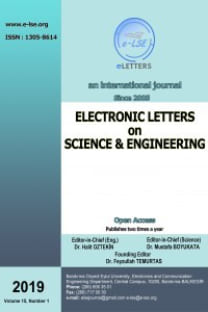Breast Cancer Prediction with Artificial Intelligence Based Clinical Decision Support System
Breast Cancer Prediction with Artificial Intelligence Based Clinical Decision Support System
Breast cancer is caused by uncontrolled cell growth and early detection is crucial for successful treatment. Diagnostic methods such as MRI, mammography, ultrasound and biopsy are used in the diagnosis of cancer. AI-based clinical decision support systems can predict treatment outcomes. A study was conducted to diagnose breast cancer using blood values and to increase performance metrics by applying discretization preprocessing. Machine learning methods were compared with 10-fold cross-validation and discretization applied and unapplied data, and the model with the best results was created. It gave the highest classification performance in breast cancer outcome prediction, with a sensitivity value of 0.828 for the Multi-Layer Sensor. In the model created by applying discretization, the Support Vector Machines increased from 55% to 72%.
___
- [1] Xu, F., Sepúlveda, M. J., Jiang, Z., Wang, H., Li, J., Liu, Z., ... & Rhee, K. (2020). Effect of an artificial intelligence clinical decision support system on treatment decisions for complex breast cancer. JCO Clinical Cancer Informatics, 4, 824-838.
- [2] Pacci, Z., Şengül, Y. A., Attar, R., Alagöz, O., & Asli, U. Y. A. R. (2021). Yapay Zeka Tabanlı Klinik Karar Destek Sistemi İle Tüp Bebek Tedavisi Gebelik Sonucu Tahmini. Emo Bilimsel Dergi, 11(22), 27-35.
- [3] Çelik, U. (2015). Baş Ağrısı Teşhisi İçin Bir Karar Destek Sisteminin Geliştirilmesi.
- [4] Kaplan, A., Güldogan, E., & Arslan, A. K. (2019, September). Prediction Of Melanoma From Dermoscopic İmages Using Deep Learning-Based Artificial İntelligence Techniques. In 2019 International Artificial Intelligence And Data Processing Symposium (Idap) (Pp. 1-5). Ieee.
- [5] Atasoy, N. A., & Demiröz, A. Makine Öğrenmesi Algoritmaları Kullanılarak Prostat Kanseri Tümör Oluşumunun İncelenmesi. Avrupa Bilim Ve Teknoloji Dergisi, (29), 87-92.
- [6] Singh, L. K., Khanna, M., & Singh, R. (2023). Artificial intelligence based medical decision support system for early and accurate breast cancer prediction. Advances in Engineering Software, 175, 103338.
- [7] Casal-Guisande, M., Álvarez-Pazó, A., Cerqueiro-Pequeño, J., Bouza-Rodríguez, J. B., Peláez-Lourido, G., & Comesaña-Campos, A. (2023). Proposal and Definition of an Intelligent Clinical Decision Support System Applied to the Screening and Early Diagnosis of Breast Cancer. Cancers, 15(6), 1711.
- [8] Candan, H., Durmuş, A., & Harman, G. (2019). Genetik Algoritma Ve Sınıflandırıcı Yöntemler İle Kanser Tahmini. Veri Bilimi, 2(1), 30-34.
- [9] Austria, Y. D., Jay-ar, P. L., Maria Jr, L. B. S., Goh, J. E. E., Goh, M. L. I., & Vicente, H. N. (2019). Comparison of machine learning algorithms in breast cancer prediction using the coimbra dataset. cancer, 7(10), 23-1. [10] Hall, M. A., & Holmes, G. (2003). Benchmarking attribute selection techniques for discrete class data mining. IEEE Transactions on Knowledge and Data engineering, 15(6), 1437-1447.
- [11] Güleryüz, D. (2020). Evaluation of waste management using clustering algorithm in megacity Istanbul. Environmental Research and Technology, 3(3), 102-112.
- [12] Candan, H., Durmuş, A., & Harman, G. Genetik Algoritma Ve Sınıflandırıcı Yöntemler İle Kanser Tahmini. Veri Bilimi, 2(1), 30-34.
- [13] Zhang, M. L., & Zhou, Z. H. (2007). ML-KNN: A lazy learning approach to multi-label learning. Pattern recognition, 40(7), 2038-2048.
- [14] Zhang, Min-Ling, and Zhi-Hua Zhou. "ML-KNN: A lazy learning approach to multi-label learning." Pattern recognition 40.7 (2007): 2038-2048.
- [15] Speiser, J. L., Miller, M. E., Tooze, J., & Ip, E. (2019). A comparison of random forest variable selection methods for classification prediction modeling. Expert systems with applications, 134, 93-101.
- [16] Leo B. Random forests. Mach Learn 2001; 45(1): 5–32.
- [17] Huang, C., Davis L. S., vd. (2002). "An assessment of support vector machines for land cover classification." International Journal of Remote Sensing 23(4): 725-749.
- [18] Cervantes, J., Garcia-Lamont, F., Rodríguez-Mazahua, L., & Lopez, A. (2020). A comprehensive survey on support vector machine classification: Applications, challenges and trends. Neurocomputing, 408, 189-215.
- [19] Abhishek, L. (2020, June). Optical character recognition using ensemble of SVM, MLP and extra trees classifier. In 2020 International Conference for Emerging Technology (INCET) (pp. 1-4). IEEE.
- [20] Khishe, M., & Safari, A. (2019). Classification of sonar targets using an MLP neural network trained by dragonfly algorithm. Wireless Personal Communications, 108(4), 2241-2260.
- [21] Davis, J., & Goadrich, M. (2006, June). The relationship between Precision-Recall and ROC curves. In Proceedings of the 23rd international conference on Machine learning (pp. 233-240).
- [22] Ozden, E., & Guleryuz, D. (2022). Optimized machine learning algorithms for investigating the relationship between economic development and human capital. Computational Economics, 60(1), 347-373.
- [23] Grandini, M., Bagli, E., & Visani, G. (2020). Metrics for multi-class classification: an overview. arXiv preprint arXiv:2008.05756.
- ISSN: 1305-8614
- Yayın Aralığı: Yılda 2 Sayı
- Başlangıç: 2005
- Yayıncı: Fevzullah TEMURTAŞ
